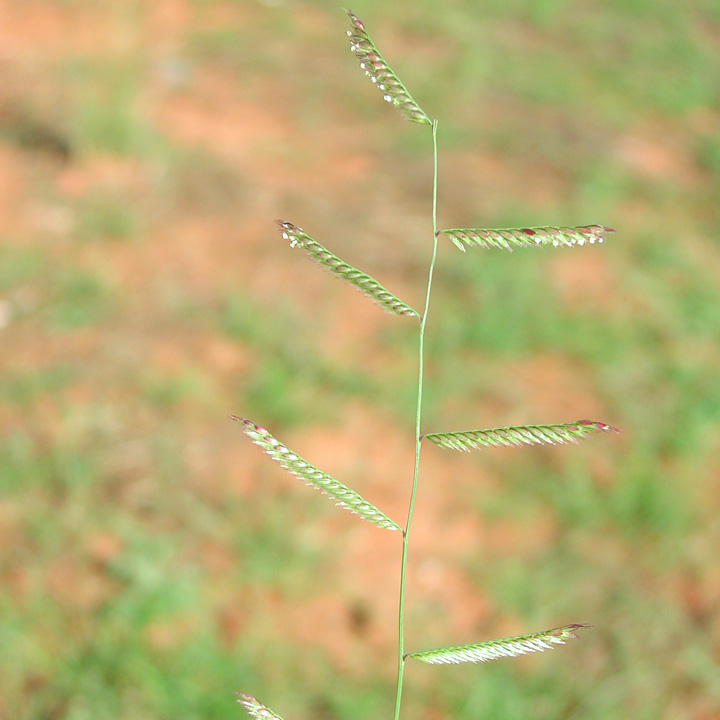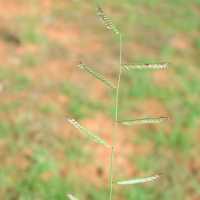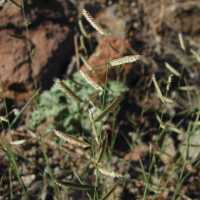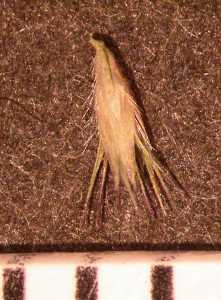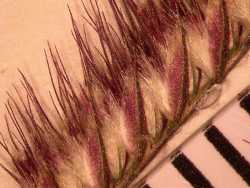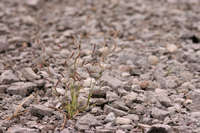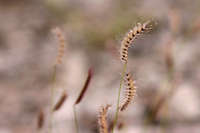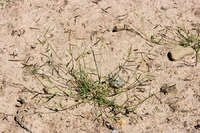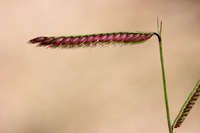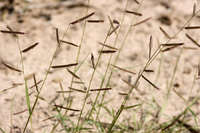Plants annual or short-lived perennials; tufted, sometimes with stolons. Culms 1-75 cm, prostrate, decumbent, or erect, sometimes rooting at the lower nodes; lower internodes glabrous. Leaves basal or cauline; sheaths usually glabrous, except for tufts of long hairs on either side of the collars; ligules 0.1-1 mm, membranous, ciliate; blades 0.5-10 cm long, 0.7-4 mm wide, adaxial surfaces usually sparsely pubescent with a few papillose-based hairs basally. Panicles 0.7-25 cm, with (2)4-9(11) branches; branches 10-30 mm, persistent, straight to arcuate, glabrous, scabridulous, or with papillose-based hairs, with 20-55 spikelets, axes terminating in a well-developed spikelet; disarticulation above the glumes. Spikelets 2.5-5 mm, pectinate, with 1 bisexual and 2 rudimentary florets. Glumes unequal, glabrous, sometimes scabridulous, apices sometimes shortly bilobed, acuminate or mucronate; lower glumes 0.7-1.5 mm; upper glumes 1.5-2.5 mm, glabrous, scabrous, or strigose, hairs not papillose-based; lowest lemmas 1.7-4 mm, densely pilose, at least on the margins, 3-awned, awns 0.5-3 mm, central awns flanked by 2 membranous lobes; lowest paleas 1.5-4 mm, pubescent on the margins, 4-lobed, 2-awned, awns 1-2 mm; anthers 0.4-0.7 mm; rachilla internodes subtending second florets terminating in a dense tuft of hairs; second florets rudimentary, 1.5-4 mm, 2-lobed, lobes rounded, 3-awned, awns 0.5-4 mm; rachilla internodes subtending third florets with glabrous or puberulent apices; third florets rudimentary, flabellate, unawned. Caryopses to 1 mm. 2n = 20.
The range of Bouteloua barbata extends from the southwestern United States to southern Mexico. It has occasionally been found as far north as southern Montana, but it does not persist there and no voucher specimens exist. There are three varieties of B. barbata. The two that grow in the Flora region are often sympatric, but are usually easily distinguished in the field in this region by their growth habit. According to Gould (1979), in the southern portion of their range the differences between the two varieties are less evident, particularly on herbarium specimens. The third variety, B. barbata var. sonorae (Griffiths) Gould, is usually stoloniferous; it is known only from the states of Sonora and Sinola, Mexico.
Bouteloua barbata is often confused with juvenile plants of the perennial B. trifida, but in B. barbata the central awn is flanked by two membranous lobes and the lowest paleas are 4-lobed and 2-awned.
Annuals, Terrestrial, not aquatic, Stolons or runners present, Stems trailing, spreading or prostrate, Stems nodes swollen or brittle, Stems erect or ascending, Stems geniculate, decumbent, or lax, sometimes rooting at nodes, Stems caespitose, tufted, or clustered, Stems terete, round in cross section, or polygonal, Stem internodes hollow, Stems with inflorescence less than 1 m tall, Stems, culms, or scapes exceeding basal leaves, Leaves mostly basal, below middle of stem, Leaves mostly cauline, Leaves conspicuously 2-ranked, distichous, Leaves sheathing at base, Leaf sheath mostly open, or loose, Leaf sheath smooth, glabrous, Leaf sheath hairy at summit, throat, or collar, Leaf sheath and blade differentiated, Leaf blades linear, Leaf blades very narrow or filiform, less than 2 mm wide, Leaf blades 2-10 mm wide, Leaf blades mostly flat, Leaf blade margins folded, involute, or conduplicate, Leaf blades mostly glabrous, Ligule present, Ligule a fringed, ciliate, or lobed membrane, Inflorescence terminal, Inflorescence with 2 or more spikes, fascicles, glomerules, heads, or clusters per culm, Inflorescence a panicle with narrowly racemose or spicate branches, Inflorescence with 2-10 branches, Inflorescence branches 1-sided, Inflorescence branches terminating in bristle or point, Flowers bisexual, Spikelets sessile or subsessile, Spikelets laterally compressed, Spikelet less than 3 mm wide, Spikelets with 1 fertile floret, Spikelets solitary at rachis nodes, Spikelets all alike and fertille, Spikelets bisexual, Spikelets disarticulating above the glumes, glumes persistent, Spikelets secund, in rows on one side of rachis, Rachilla or pedicel glabrous, Glumes present, empty bracts, Glumes 2 clearly present, Glumes distinctly unequal, Glumes equal to or longer than adjacent l emma, Glume equal to or longer than spikelet, Glumes 1 nerved, Lemma coriaceous, firmer or thicker in texture than the glumes, Lemma 3 nerved, Lemma glabrous, Lemma body or surface hairy, Lemma apex dentate, 3-5 fid, Lemma teeth unequal. central tooth longer, Lemma distinctly awned, more than 2-3 mm, Lemma with 3 awns, Lemma awn less than 1 cm long, Lemma margins thin, lying flat, Lemma straight, Palea present, well developed, Palea membranous, hyaline, Palea shorter than lemma, Palea 2 nerved or 2 keeled, Stamens 3, Styles 2-fid, deeply 2-branched, Stigmas 2, Fruit - caryopsis, Caryopsis ellipsoid, longitudinally grooved, hilum long-linear.
Common Name: sixweeks grama
Duration: Annual
Nativity: Native
Lifeform: Graminoid
General: Small tufted annual grass with numerous geniculate, spreading stems, typically 25 cm or less, often much less; weakly developed roots, branching from base.
Vegetative: Leaves sometimes pilose around margins of throat; sheaths glabrous, generally with scarious or hyaline margins; ligule dense fringe of hairs, 1 mm long, blades mostly flat with a loosely involute tip, 1-2 mm broad, scaberulous above, often with narrow whi
Inflorescence: Spikes mostly 1-2 cm long and 2 mm broad excluding awns, occasionally larger; 4-12 spikes per stem, comb-shaped, nearly straight to moderately arched; lemma and rudiment awns often less than 2 mm long.
Ecology: Found in open, rocky or sandy slopes and washes, often weedy on disturbed soils below 6,000 ft (1829 m); flowers summer and fall.
Distribution: s CA, and s NV east to s UT, CO and south through TX; to s MEX.
Notes: The genus Bouteloua is characterized by its memorable panicles, which are comprised of one to many solitary, spikelike branches. Each of these spikelike branches has 2 rows of sessile spikelets all pointing the same direction, often giving the branch a one-sided, comblike appearance. Spikelets have 1-2 or occasionally 3 florets each, but only the basal floret is bisexual; distal florets are sterile or staminate. B. barbata is distinguished in that genus by being a small annual (sometimes short-lived perennial) with several inflorescence branches, 1-3 cm long, per culm, and spikelets in a tight pectinate row. Var. rothrockii has a perennial habit, hard knotty bases, and well-developed roots.
Ethnobotany: Used as fodder, in ceremonial settings, and medicinally.
Etymology: Bouteloua named for brothers Claudio (1774-1842) and Esteban (1776-1813) Boutelou Agraz, Spanish botanists and horticulturalists; barbata is from Latin barba, beard.
Synonyms: Bouteloua arenosa, Chondrosum barbata, C. exile, C. microstachyum, C. polystachyum, C. subscorpioides
Editor: SBuckley 2010, FSCoburn 2014, AHazelton 2015


